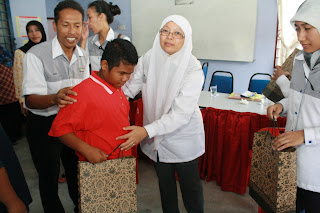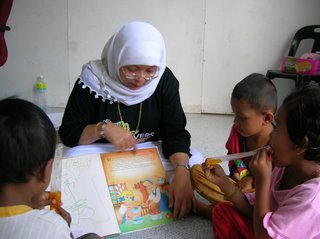Image Source: http://blog.publictransportation.org/category/policy/
Monday, January 25, 2016
Greener and Sustainable Transportation
In most cities in Malaysia, very few people uses the bike paths. Most users mainly cycle for recreational purposes only. In Holland, a country where cycling has become the norm, the dutch uses bicycle for their daily commuting to work, to school, to shop.. etc.. Making people leave their car at home and take public transportation still cannot be implemented in Malaysia. It has become a standard for one household to have three cars. This is also true for the lower middle income neighborhoods. We can see cars lined up the residential streets. I think we should make owning a second car expensive.. at the same time public transportation must be efficient, only then people would want to take the buses and trains. With that in place, we can hope people would cycle from home to the nearest transit station. Hmmm... it sounds like utopia at the rate we are going now.
Tuesday, August 11, 2015
Friday, March 15, 2013
PearL of wisDom # 4
For beautiful EYES, look for the GOOD in others
For beautiful LIPS, speak only words of KINDness
......
- Audrey Hepburn
Thursday, September 08, 2011
Lawatan Ke Rumah Amal Yan, Kedah






 Siswa-siswi Sarjana Muda Perancangan Bandar dan Wilayah Semester 07B, Sessi Disember 2010-Mei 2011 telah mengadakan program amal kommuniti semasa lawatan akademik mereka untuk projek studio Penyediaan Rancangan Tempatan Daerah Yan. Kajian tapak yang mengambil masa 6 hari bermula Isnin 7 Februari 2011 telah dipenuhi dengan pelbagai taklimat, tinjauan ke kampung-kampung, kawasan pertanian, perindustrian serta tarikan pelancongan yang terdapat disekitar daerah. Para pelajar juga menjalankan pelbagai jenis kajiselidiek mengikut keperluan silibus mereka.
Siswa-siswi Sarjana Muda Perancangan Bandar dan Wilayah Semester 07B, Sessi Disember 2010-Mei 2011 telah mengadakan program amal kommuniti semasa lawatan akademik mereka untuk projek studio Penyediaan Rancangan Tempatan Daerah Yan. Kajian tapak yang mengambil masa 6 hari bermula Isnin 7 Februari 2011 telah dipenuhi dengan pelbagai taklimat, tinjauan ke kampung-kampung, kawasan pertanian, perindustrian serta tarikan pelancongan yang terdapat disekitar daerah. Para pelajar juga menjalankan pelbagai jenis kajiselidiek mengikut keperluan silibus mereka.Sebelum pulang ke kampus, 28 orang pelajar berkenaan telah mengadakan program amal di Rumah Amal Yan, sebuah pusat latihan warga kurang upaya. Para pelajar telah mengumpul derma dari pelbagai pihak di UiTM untuk program amal berkenaan. Antara yang menyumbang adalah para pelajar, pensyarah dan staf Fakulti Senibina, Perancangan dan Ukur, penghuni kolej serta rakan-rakan mereka. Sumbangan juga diterima dari agensi dan individu luar.
 Pelbagai aktiviti diadakan bersama dengan kanak-kanak OKU yang hadir pada petang yang indah itu. Para guru-guru serta petugas Rumah Alam Yan juga turut hadir. Sele
Pelbagai aktiviti diadakan bersama dengan kanak-kanak OKU yang hadir pada petang yang indah itu. Para guru-guru serta petugas Rumah Alam Yan juga turut hadir. Sele pas mengikuti beberapa aktiviti, semua yang hadir menikmati sedikit jamuan yang disediakan oleh para pelajar.
pas mengikuti beberapa aktiviti, semua yang hadir menikmati sedikit jamuan yang disediakan oleh para pelajar.Siswa-siswi kemudian menyanyikan beberapa buah lagu diikuti dengan majlis penyampaian sumbangan kepada setiap murid OKU dan barangan kepada Penyelaras Rumah Amal Yan. Penyampaian sumbangan disempurnakan oleh pensyarah pengiring, Prof madya Dr Habsah Hashim. Yang paling menyayat hati adalah disaat perpisahan apabila murid-murid OKU menyanyikan lagu "Namun ku Punya Hati" dengan cara dan kemampuan mereka sendiri. Ramai yang tersentuh dengan penyampaian bersahaja penuh ikhlas dari mereka..ramai yang menitiskan airmata... ada murid OKU yang memeluk abang-abang serta kakak-kakak yang sudi meluangkan masa untuk bermesra dengan mereka petang itu. Namun...kami harus pulang ke Shah Alam..tengah malam baru kami sampai ke kampus.
Thursday, November 04, 2010
Monday, November 16, 2009
LiVe LiFe
Sunday, March 08, 2009
Jejak Jogja: Lessons on Life
 29 students and 3 lecturers from UiTM's Town & Regional Planning Department had gone for a study trip to Yogyakarta and Solo from 2 - 6 March 2009. During the five days trip, the group managed to forged closer ties with planning students from Universitas Gadjah Mada and made two presentations about planning system and urban design in Malaysia. Students and staff from UGM had warmly welcome the UiTM's group. The five days stay in Yogyakarta and a short day trip to Solo were not only filled with visits to interesting tourist destinations in the special region, but had also portrayed the Indonesian culture and heritage. Visting Borobudur, one of site listed in the UNESCO world heritage list as depicted in the photo above and going up to the Ketep Pass to have a glimpse of the Merapi volcano were the highlights of the trip. However, the midday rain and the fog at the mounta
29 students and 3 lecturers from UiTM's Town & Regional Planning Department had gone for a study trip to Yogyakarta and Solo from 2 - 6 March 2009. During the five days trip, the group managed to forged closer ties with planning students from Universitas Gadjah Mada and made two presentations about planning system and urban design in Malaysia. Students and staff from UGM had warmly welcome the UiTM's group. The five days stay in Yogyakarta and a short day trip to Solo were not only filled with visits to interesting tourist destinations in the special region, but had also portrayed the Indonesian culture and heritage. Visting Borobudur, one of site listed in the UNESCO world heritage list as depicted in the photo above and going up to the Ketep Pass to have a glimpse of the Merapi volcano were the highlights of the trip. However, the midday rain and the fog at the mounta in land made it impossible to view the volcano. See picture below.
in land made it impossible to view the volcano. See picture below. The visit to Parangtritis beach to view the serenity of the sunset, the "andong" (horse carriage) ride to Puriwisata for dinner and watching the Ramayana theatre plus visits to royal palaces - the Mangkunegaran palace in Surakarta (Solo) & Kraton in Yogyakarta and the urban conservation site at Taman Sari had certainly made the five day's tour busy and interesting. Though the students learned a lot from the visit to UGM and the sightseeing and visiting tourist attraction places, one very important lesson that the students got from this visit is through observing the living conditions and the interactions they had with the ordinary people on the streets of Yogyakarta.
 Malaysia and Indonesia might have many similarities, but had very different political system and governmental policies. As such our Indonesian cousins had not enjoy the type of development that we, in Malaysia had taken for granted. The most notable difference experienced by visitors to the Java island the moment they step out of the airport is the high density of people, compactness of the buildings and narrowness of the streets. People seems to be everywhere, some busy at work, many on the move, some are doing whatever they can to earn a living ... to the extent of begging ... and many more just seems to be doing nothing but passing time. The high proportion of poor people is reflected in the urban fabric .. for example, the trishaw that has became obsolete in Malaysian cities is still heavily used by people as cheaper me
Malaysia and Indonesia might have many similarities, but had very different political system and governmental policies. As such our Indonesian cousins had not enjoy the type of development that we, in Malaysia had taken for granted. The most notable difference experienced by visitors to the Java island the moment they step out of the airport is the high density of people, compactness of the buildings and narrowness of the streets. People seems to be everywhere, some busy at work, many on the move, some are doing whatever they can to earn a living ... to the extent of begging ... and many more just seems to be doing nothing but passing time. The high proportion of poor people is reflected in the urban fabric .. for example, the trishaw that has became obsolete in Malaysian cities is still heavily used by people as cheaper me ans of transportation, besides being used for "wisata" (tourism) .. together with the "andong" (horse-carriage). As the world's fourth largest country in terms of population (after, China, India and USA), Indonesia certainly depicts the crisis described by Paul Earlich (1968) in his book "The Population Bomb". This is especially true in the island of Java where 60 percent of the Indonesian population stays. The government's transmigration policy that aims at bringing people to other islands like Kalimantan, Sulawesi, Sumatera etc. has not translated well in
ans of transportation, besides being used for "wisata" (tourism) .. together with the "andong" (horse-carriage). As the world's fourth largest country in terms of population (after, China, India and USA), Indonesia certainly depicts the crisis described by Paul Earlich (1968) in his book "The Population Bomb". This is especially true in the island of Java where 60 percent of the Indonesian population stays. The government's transmigration policy that aims at bringing people to other islands like Kalimantan, Sulawesi, Sumatera etc. has not translated well in  practice. Javanese would not want to leave the Java land ... no matter how difficult life is in the disaster-prone island.
practice. Javanese would not want to leave the Java land ... no matter how difficult life is in the disaster-prone island.The Bachelor in Town & Regional Planning 08 students who went for "Jejak Jogja" had seen how people are making whatever they can to earn a living. Surely they will not forget being chased by the "asungan" sellers at Borobudur who would be willing to offer unbelievably low prices that had tempted many students to buy the souvenirs. The ever willing "amen" singers and musician who would use anything ... from a guitar to just bottles and sticks to entertain customers along Malioboro street, in the heart of Yokyakarta. Not to mention the sad encounters with beggers on the streets. The local authority had to put up signs as below to curb the situation. W
 herever we go, there will always be someone (at times many such persons) who would offer any form of service ... parking guide, crossing street etc. etc ... for a small amount of money ... just to earn a living!
herever we go, there will always be someone (at times many such persons) who would offer any form of service ... parking guide, crossing street etc. etc ... for a small amount of money ... just to earn a living!The "Jejak Jogja" project initiated by the BTRP 08 (Dec'08-Apr"09) students has certainly been a fruitful effort. Besides learning the differences in the planning system, the urban form and visiting interesting tourist attractions in daerah istimewa Yokyakarta and Surakarta, the experience about life through walking the streets of Jogja is the most priceless lesson that the students could learn ... this certainly cannot be taught through lectures in the classroom. Finally, the friendship that were forged with the UGM's students & staff and also the cheerful Pak Karjo, the tourist guide and the wonderful "mas-mas" from Jom Jalan Travel had certainly made the five-days stay a memorable one.
Subscribe to:
Comments (Atom)



.jpg)


